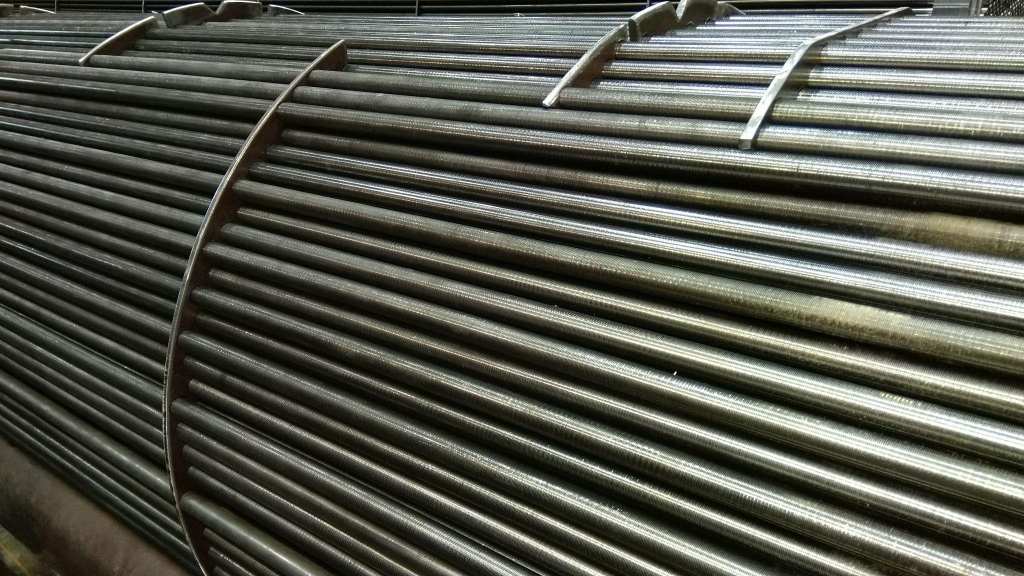
When to Use Low-Finned Tubes in Shell & Tube Heat Exchangers
Low-finned tubes are a type of heat exchanger tube that feature small fins on the outer (and/or inner) surface, designed to enhance heat transfer in shell and tube heat exchangers. These tubes offer several benefits over traditional bare (plain) tubes, including increased surface area for heat transfer, improved heat transfer coefficients, and enhanced thermal performance. Let’s explore when to use low-finned tubes in shell & tube heat exchangers.

Economic Differences Finned and Bare Tubes
The decision to use low-finned tubes over plain tubes in a shell and tube heat exchanger generally comes down to performance and cost considerations. While finned tubes have a higher initial cost compared to plain tubes, they can offer significant capital and operating cost savings in terms of improved heat transfer efficiency, reduced heat exchanger size, and lower operating costs. It is important to evaluate the lifecycle costs and benefits of finned tubes for each specific application to determine the most cost-effective solution.
How Are Low-Fin Tubes Manufactured?
Low-fin tubes are manufactured primarily through a cold rolling process. In this method, a smooth tube is fed into a finning machine, which uses a set of rotary discs to roll and form helical fins on the tube’s exterior surface. The cold rolling technique not only forms the fins but also work-hardens the material, enhancing its strength and heat transfer properties. The fins increase the surface area of the tube, significantly improving the tube’s heat transfer efficiency, making these tubes especially useful in applications requiring enhanced heat exchange capabilities.

Thermal and Mechanical Design Factors
When designing and selecting a low-fin tube for a shell and tube heat exchanger, several factors and geometries must be considered. The fin height, thickness, and pitch are critical, as they determine the surface area and turbulence, enhancing heat transfer. Material compatibility with the fluids, thermal conductivity, and resistance to corrosion are also key. The tube diameter and (under-fin) wall thickness affect the structural integrity and pressure capabilities. Additionally, the length of the tube and the number of tube passes must be tailored to optimize fluid dynamics and heat transfer for specific operational conditions.
Using Higher Heat Transfer Coefficients
Low-finned tubes are an excellent choice when higher heat transfer coefficients are required in shell and tube heat exchangers. The fins on the tube surface increase the effective surface area, allowing for more efficient heat transfer between the shell-side and tube-side fluids. This increased efficiency can lead to more compact heat exchanger designs, reduced costs, and improved overall performance.
An ideal application for low-finned tubes is when the shell-side heat transfer coefficient is governing the overall heat transfer, which can occur with a gas process on the shell-side and a liquid process tube-side.

Heat transfer in shell & tube exchangers with gas processes on both the tube-side and shell-side can be optimized using tubes with both an external and internal fin to maximize heat transfer surface area. Alternatively, the tube-side heat transfer coefficient can be enhanced by increasing the turbulence using tube internals like twisted-tape turbulators or wire mesh inserts (CALGAVIN hiTRAN for example).
Best Services for Low-Finned Tubes
Low-finned tubes are well-suited for a variety of applications in shell and tube heat exchangers. Some examples include:
-
- Gas processing
-
- Chemical and petrochemical plants
-
- Petroleum refineries
-
- SAGD facilities
-
- Power generation facilities
-
- Refrigeration and air conditioning processes
In these applications, low-finned tubes can provide enhanced heat transfer, improved efficiency, and reduced fouling, leading to better overall performance and lower operating costs.
Contact Altex Industries for Services and Fin Tubes for Shell & Tube Heat Exchangers
Altex Industries is a leading provider of high-quality fin tube heat exchangers, fabrication, maintenance, and turnaround services. With extensive experience in the design, manufacture, and application of low-finned exchangers, Altex Industries can help you select the optimal tube configuration for your specific needs. Contact Altex Industries to learn more about our services and how low-finned tubes can improve the performance of your shell & tube heat exchangers.





